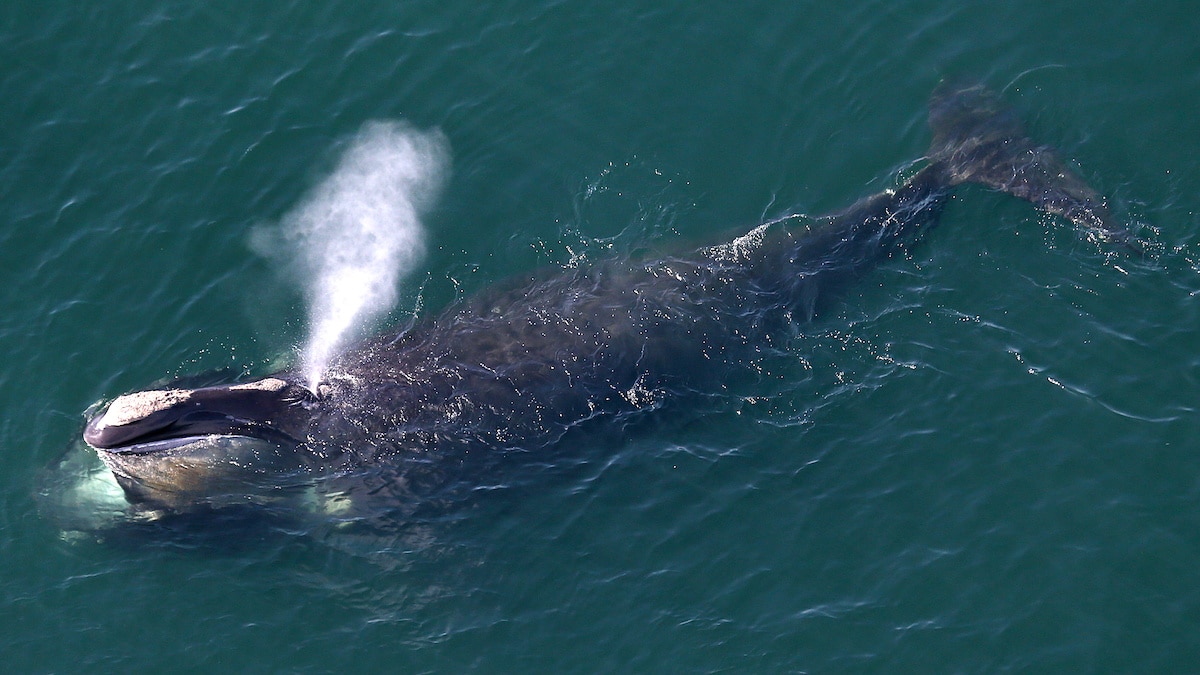

A North Atlantic right whale feeds off the shores of Duxbury Beach, Massachusetts in 2015. David L. Ryan / The Boston Globe via Getty Images
The population of extremely endangered North Atlantic right whales has fallen even further in the last year, the National Oceanic and Atmospheric Administration (NOAA) said Monday.
The agency said that there were only 366 of the whales as of January 2019, down from 412 in January of 2018, The Associated Press reported. But their numbers are likely even lower than that. NOAA Fisheries has documented the deaths or likely fatal injuries of a further 15 whales since, the Conservation Law Foundation (CLF) pointed out.
“These population estimates are devastating,” CLF senior attorney Erica Fuller said in response to the news. “The outlook is grim if we do not act today. We know human activities are decimating this population, what will it take for federal fishery managers to finally take action to protect these magnificent animals?”
In dire news for an already critically endangered species, @NOAAFisheries just announced that they're estimating the population of North Atlantic #rightwhales was at just 366 in January 2019 — 11 percent fewer whales than were estimated to exist the year before. pic.twitter.com/qGvHWmpv2f
— David Abel (@davabel) October 26, 2020
Atlantic right whales have been protected by the U.S. government since 1972, according to The Associated Press. Their numbers were initially devastated by commercial whaling. Today, the leading causes of death for the whales are being struck by vessels and getting entangled in fishing gear, Boston Globe reporter David Abel wrote on Twitter.
Right whales have also struggled to reproduce in recent years, according to The Associated Press. Thirteen whales were born in the last two years, but two are already thought to have died, Abel reported in The Boston Globe. One was actually found dead, and another was hit by a boat just hours after being born. Another alarming data point from NOAA Fisheries is that there are only 94 breeding females left in the species.
Further, the decline in numbers between 2018 and 2019 is partly because the whales’ numbers were overestimated in 2018, NOAA marine mammal take reduction team coordinator Colleen Coogan told The Boston Globe. She said that updated photo identification data suggested there were only 383 whales in 2018, not 412. Coogan noted that the 2019 numbers were preliminary and would be reviewed before a federal assessment of the species due next year.
The population of right whales peaked in 2011 at 481. Since then, an average of 24 whales have died every year. But the population can only withstand less than one death a year to avoid extinction.
“Given the low population numbers … it is essential that we work together to protect every North Atlantic right whale in order to avoid extinction for this endangered species,” Coogan wrote in an email to members of a federal advisory board organized to find ways to protect the whales from mortality.
CLF, the Center for Biological Diversity, the Humane Society of the United States (HSUS) and other groups sued NOAA Fisheries to better protect right whales from getting entangled in lobster lines in the Gulf of Maine. A judge ruled in their favor, and the agency now has until May 2021 to issue new regulations.
“If we don’t act quickly, right whales are headed rapidly toward extinction,” HSUS marine issues field director Sharon Young told The Boston Globe. “It is appalling to think this nation would permit the extinction of a whale species in our waters. It’s time to stop talking and take action.”
The new NOAA figures weren’t the only warning sign for North Atlantic right whales to be reported this week. For the first time in four decades, marine scientists with the New England Aquarium did not observe any right whales in the Bay of Fundy this year, the Bangor Daily News reported.
They were able to confirm that citizen scientists took pictures of two whales in or near the bay. However, in past years, as many as 50 to 150 whales would forage in the body of water between Maine, Nova Scotia and New Brunswick. The numbers have been falling since 2010 because of another threat: the climate crisis.
“It’s just a reflection of how the ocean is changing with climate change, and their food resource, plankton, they’re not blooming at the same time and in the same areas that they used to, so it’s a reflection that for them and for our oceans things are changing pretty dramatically,” New England Aquarium researcher Amy Knowlton told the Bangor Daily News.
- Sixth North Atlantic Right Whale Found Dead Prompts Concern ...
- Lobster Industry Ensnared in North Atlantic Right Whale Deaths ...
- First North Atlantic Right Whale Calf of the Season Spotted off ...
- Endangered North Atlantic Right Whale Calves Spotted Off Coast
- 14 Endangered North Atlantic Right Whale Calves Spotted This Season - EcoWatch
- Northern Right Whales Experience Highest Birth Rate Since 2015
- NOAA Plan Might 'Delay' Right Whales Extinction, But Not Save Them, Experts Warn
- Climate Crisis Is Driving Decline of Critical Endangered Whale Species

 233k
233k  41k
41k  Subscribe
Subscribe 